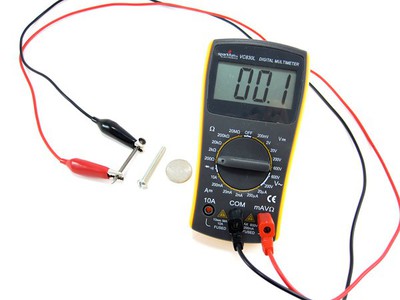Summary
Original project by Charlie Zhai, AMD.
Edited by Andrew Olson, Ph.D., and Ben Finio, Ph.D., Science Buddies
Sources
- Kuphaldt, T.R., 2003. Kelvin (4-wire) Resistance Measurement, All About Circuits: Volume I—DC. Retrieved April 12, 2006.

If you want a Project Idea with full instructions, please pick one without an asterisk (*) at the end of the title.
Abstract
Measuring the value of a resistor with a multimeter is pretty simple. You set the multimeter to measure resistance, connect the two leads to the resistor (possibly using some handy alligator clips), and read the resistance value. This is called a two-point measurement (one probe on each of the two resistor leads). But what if the resistance you want to measure is very small, in the milli or micro-ohm (mΩ or μΩ) range? This can introduce problems because many low-cost multimeters are not designed to measure resistances this small directly. The contact resistance between the test probes and the object, or even the resistance of the leads themselves, can also throw off the reading. One way around this problem is to make a four-point resistance measurement, also referred to as a "Kelvin measurement." See the All About Circuits reference in the Bibliography for a detailed explanation of this measurement technique.
Can you use the four-point method to measure the resistance of some objects with small resistances? Small metal objects you can find around your house, like those in Figure 1 (coins, nails, and screws etcetera) should work well. How do results from the four-point method compare to those from the usual two point-method? Is one method more accurate? What about comparing the two techniques to measure resistors? Is the four-point method necessary for larger resistances?

Figure 1. The normal two-point method for measuring resistance. The multimeter cannot accurately measure the very low resistances of these objects.
Note: typically four-point resistance measurements are made using Kelvin clips, which are very expensive. For purposes of this experiment, you should be able to use regular alligator clip test leads to connect to your multimeter probes. You can also purchase banana to alligator adapters, but make sure that the banana plugs are the right size for your multimeter.
Bibliography
- Kuphaldt, T.R. (n.d.). Kelvin (4-wire) Resistance Measurement. All About Circuits: Volume I—DC. Retrieved July 9, 2016.
- Nuckolls, B. (n.d.). Practical Low Resistance Measurements. The AeroElectric Connection. Retrieved July 9, 2016.
- If you need to brush up on the basics of current, voltage, and resistance, the following references should be helpful:
- Science Buddies. (n.d.). How to Use a Multimeter.. Retrieved July 9, 2016.
- Mastascusa, E.J. (n.d.). An Introduction to Electrical Measurements. Department of Electrical Engineering, Bucknell University. Retrieved July 9, 2016.
- An online source for information on Kirchhoff's Laws is:
Burley, I. et al. (n.d.). Kirchhoff's Laws. Introductory Physics Notes, University of Winnipeg. Retrieved July 9, 2016.
Ask an Expert
Global Connections
The United Nations Sustainable Development Goals (UNSDGs) are a blueprint to achieve a better and more sustainable future for all.
Variations
- Investigate the temperature dependence of resistance by repeating the measurements at different temperatures. You can use a hair dryer to heat up the resistors and conductors (or put them in the refrigerator or freezer for awhile). Keep in mind that the metals are normally very good thermally conductive material, so their temperatures can change rapidly.
- For a slightly more advanced project, see the article by Bob Nuckolls in the Bibliography (Nuckolls, 2004) on building a simple circuit for making accurate 4-wire resistance measurements with a single multimeter.
Careers
If you like this project, you might enjoy exploring these related careers:
Related Links
- Science Fair Project Guide
- Other Ideas Like This
- Electricity & Electronics Project Ideas
- My Favorites










